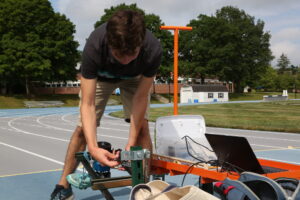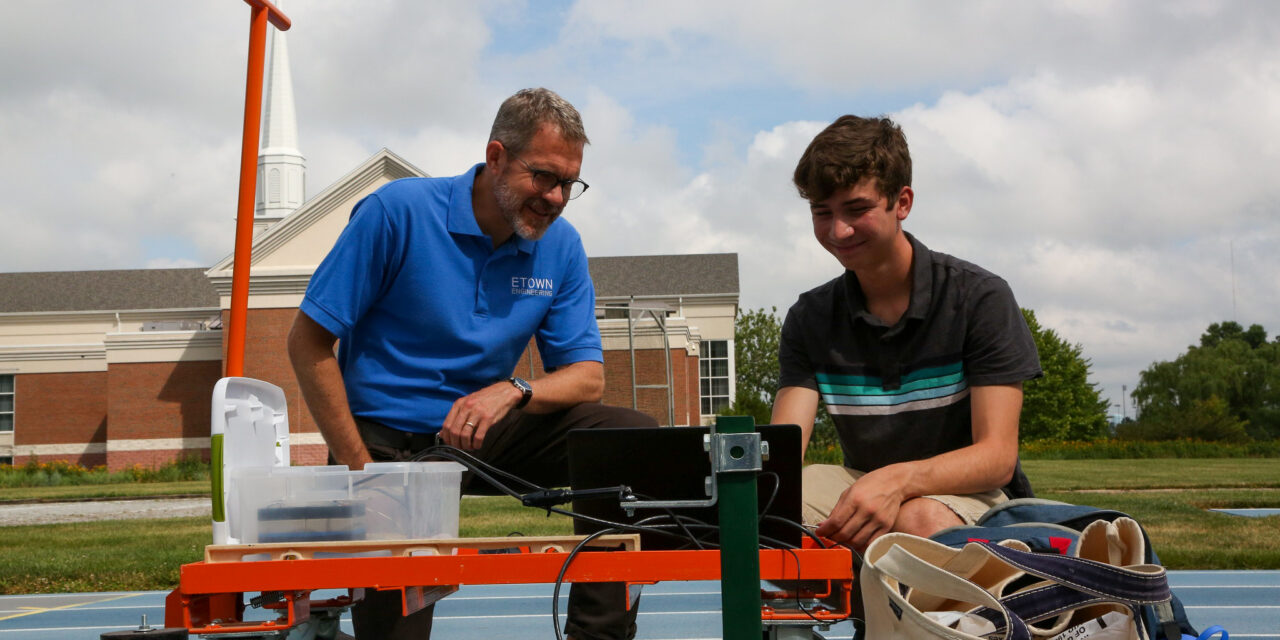Elizabethtown College Track & Field/Cross Country student-athlete Thomas Urrunaga ’25 is on-campus this summer testing differences in force on various running surfaces. Using a self-constructed device that mimics a runner’s stride, the Engineering major is working to debunk myths that running on softer surfaces will decrease the chances of injury and hopes to publish his findings in the track & field coaching magazine, “Techniques.” In August, Urrunaga presented his research at the American Society of Biomechanics (ASB) Biomechanics Summer Undergraduate Research Experience(B-SURE) poster session.
This Summer Creative Arts and Research Program (SCARP) project and collaboration with a faculty mentor is a continuation of a previous project which used sensors placed inside athlete’s shoes to measure surface-force variability.
 Title of Research
Title of Research
Surface vs. Force: Myth or Truth?
Student Researcher
Thomas Urrunaga ’25 (Engineering major)
Faculty Mentor
Kurt DeGoede, Professor of Engineering and Physics
What are you researching?
Thomas: I am researching impact surfaces in regard to running. I am testing several different pairs of shoes to try and discover whether the surface that one runs on matters when one is wearing a shoe. This is very important in the running community especially when dealing with an injury, as a larger measured force should result in a larger risk of injury.
The device that we are using mimics the stride of a runner. Depending on the shoe, the device falls at a force of 650 to 950 newtons, as well as a speed of 1.8 to 1.9 meters per second. This is quite similar to the force a runner’s heel experiences when their heel strikes; the device’s speed is also similar to the runner’s during this form.
Why did you choose this topic?
Thomas: I chose this topic because I am on the cross country and track and field teams and therefore very interested in running. I am also an engineering major interested in the biomedical concentration. This project stood out to me because it combines these two interests of mine.
What is the most interesting aspect of this research?
Thomas: The most interesting part of my research so far has been the learning aspect. Throughout this project, I have gained a lot of hands-on experience in so many different parts of research. Coming into Etown I never experienced many hands-on skills necessary for engineering, such as data collection and workshop skills, so this has been a huge help for me that will help in my future, both at Etown and after Etown.
How has your faculty mentor helped you?
Thomas: Dr. DeGoede has provided several years of experience in how to get over hurdles and challenges that are involved with the project. As this is an ongoing project, Dr. DeGoede has a larger picture view of where the research started, and the preliminary results achieved from those studies. Dr. DeGoede additionally has years of research revolving around biomechanics which has helped us model the structure we are using for this project to simulate the heel strike in running.
Hear from the faculty mentor – Kurt DeGoede
“Most in the running community assume impact forces and injury risk are lower when running on ‘softer’ surfaces,” DeGoede said. “While this is true in the extreme, most surfaces runners chose to train on do not exhibit any difference in the impact force. The stiffness in the foam is hundreds of times less than even the softest running of these surfaces, so the impact forces do not change significantly from surface to surface.
“Our previously reported data from human subject trials demonstrated this, but with a large variability/uncertainty in the data set. Thomas’s experiment will provide a far tighter data set, reinforcing this finding.”

